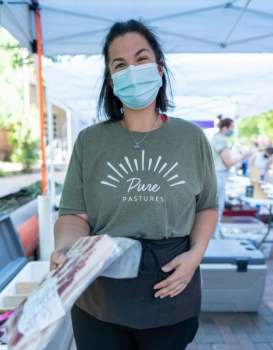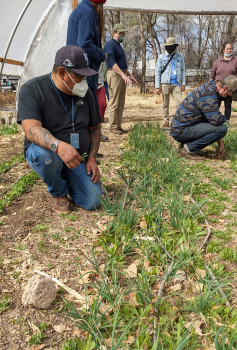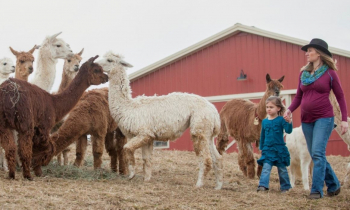Chelenzo Farms sprouted from the unexpected move of a physician and a writer from New York during the height of the pandemic. Chelsea Hollander and Lorenzo Dominguez found land in Cerrillos, New Mexico, 20 miles south of Santa Fe. There, the husband-and-wife team combined their names and turned dreams into reality — Chelenzo Farms.
“Our overall focus is on regenerative agriculture, dryland farming, and ecosystem restoration in the high mountain desert of New Mexico, and our operating philosophy rests on the three pillars of Education, Research, and Community,” said Lorenzo.
Lorenzo made it a mission to talk with as many landowners as possible surrounding him in a 30-mile radius to learn about the local knowledge base. They use ATTRA Sustainable Agriculture’s Internship Hub to connect with interns, joined NCAT’s Soil for Water peer-to-peer network, and added their place on Soil for Water’s Regenerative Atlas of America.
The May 2021 move to their 350-acre homestead in New Mexico was the downshift they needed. They now grow their own plant-based diet, along with using livestock to restore their land and utilizing Indigenous practices to conserve water.
More than 215 farmers have joined the free and voluntary Soil for Water network, a regenerative agriculture project supported in part by NCAT and NCAT’s ATTRA Sustainable Agriculture program. The project aims to include farmers who discover and share land management practices that improve soil health, catch more water in soil, reduce erosion, sustain diverse plant and animal life, and filter out pollutants, all while improving profitability.
“We live and aspire to grow in the desert of New Mexico. Water has been an invaluable resource around here for centuries and access to it is strained exponentially each year. This is why we are focused on harvesting water from nature with earthworks and methods used by Indigenous populations around the world for thousands of years,” said Lorenzo.
Photo courtesy Chelenzo Farms.

 First-generation farmers Jeremiah and Maggie Eubank manage 2,000 acres in Texas Hill Country. They’re raising cattle, sheep, pigs, chickens, and ducks on land between San Antonio and Austin. It’s beautiful, tough land that Maggie Eubank says has been overgrazed for a century. They’re working to change that.
First-generation farmers Jeremiah and Maggie Eubank manage 2,000 acres in Texas Hill Country. They’re raising cattle, sheep, pigs, chickens, and ducks on land between San Antonio and Austin. It’s beautiful, tough land that Maggie Eubank says has been overgrazed for a century. They’re working to change that.  “It was cool to see and hear stories about how farmers started similar to where I’m at right now and how they learned to use grants, have the drive, and make it a business,” he says. “I loved the training; it was amazing.”
“It was cool to see and hear stories about how farmers started similar to where I’m at right now and how they learned to use grants, have the drive, and make it a business,” he says. “I loved the training; it was amazing.”  Maynard says when she set out to launch her alpaca farm, she had no idea of the sustainable agriculture resources and farmer-veteran community that already existed. “When I came on to my land, it wasn’t in great shape,” she says. “I overgrazed my fields when I first started. I didn’t know how to manage ruminants correctly. ATTRA gave me the tools I needed to be able to do that. Not only did my land rebound, but the forage production per acre has at least doubled if not tripled because of the resources ATTRA empowered me with. I am now able to grow much more with less.”
Maynard says when she set out to launch her alpaca farm, she had no idea of the sustainable agriculture resources and farmer-veteran community that already existed. “When I came on to my land, it wasn’t in great shape,” she says. “I overgrazed my fields when I first started. I didn’t know how to manage ruminants correctly. ATTRA gave me the tools I needed to be able to do that. Not only did my land rebound, but the forage production per acre has at least doubled if not tripled because of the resources ATTRA empowered me with. I am now able to grow much more with less.”